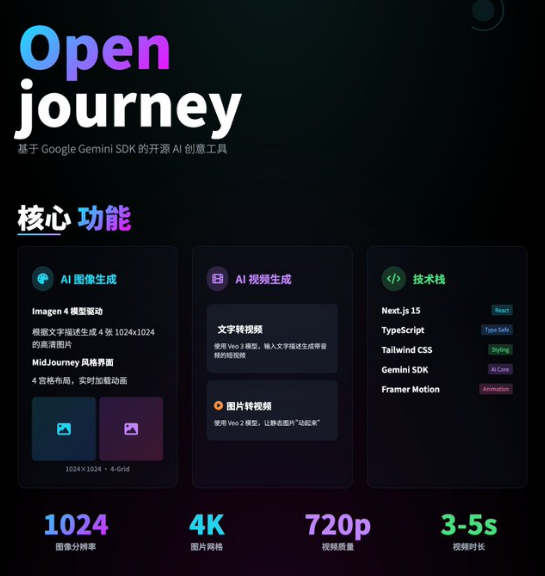Recently, the innovative project Openjourney developed by @ammaar has attracted widespread attention. This tool not only cleverly mimics MidJourney in terms of interface but also deeply integrates the Google Gemini SDK at its technical core, and incorporates powerful Imagen4 and Veo2/3 models, providing users with an all-in-one AI image and video generation solution. Openjourney aims to allow users to easily use AI to generate high-quality images and videos, while enjoying an intuitive interactive experience similar to that of MidJourney.

Openjourney fully utilizes the Imagen4 model, which can generate four 1024x1024 pixel high-definition images based on user-provided text descriptions. Its interface design draws inspiration from MidJourney's classic four-grid layout and adds real-time loading animations, greatly enhancing the user experience. The generated images can be directly downloaded, zoomed in for viewing, or even converted into videos with one click.
In terms of video generation, Openjourney also performs excellently: using the Veo3 model, users can input a text description to generate a 3-5 second 720p short video with audio; leveraging the Veo2 model, static images can come to life, allowing users to select an image and add a text description to convert it into an animated video. The video content is displayed in a 2x2 grid format, and automatically plays when the mouse hovers over it, offering strong interactivity.
Openjourney also carefully considers user experience. Its input box is simple and intuitive, and users can start the generation process by clicking "Generate" or pressing Enter after entering their prompt. The platform supports full-screen viewing and downloading of works, and allows users to easily browse their generation history using arrow keys, like flipping through a photo album. The smooth animation effects of the interface are achieved through Framer Motion, and the "skeleton screen" placeholder during loading further enhances the professional feel.
Openjourney's technology stack is modern and robust, making it ideal for developers to learn and perform secondary development. It uses Next.js 15 (including App Router and Turbopack) as the front-end framework, ensuring excellent performance and development experience; TypeScript is used to improve code reliability; Tailwind CSS v4 is leveraged to quickly build beautiful interfaces; Framer Motion is utilized to achieve smooth interactive effects; and ShadCN and Radix UI are integrated to ensure the aesthetics and accessibility standards of the interface. Its core AI capabilities are realized by calling the Imagen4 and Veo2/3 models through the Google Gemini SDK for image and video generation.
The release of Openjourney undoubtedly brings a powerful and promising alternative to the MidJourney for the open-source community, showcasing the broad prospects of Google AI technology in creative applications.
Address: https://github.com/ammaarreshi/openjourney
